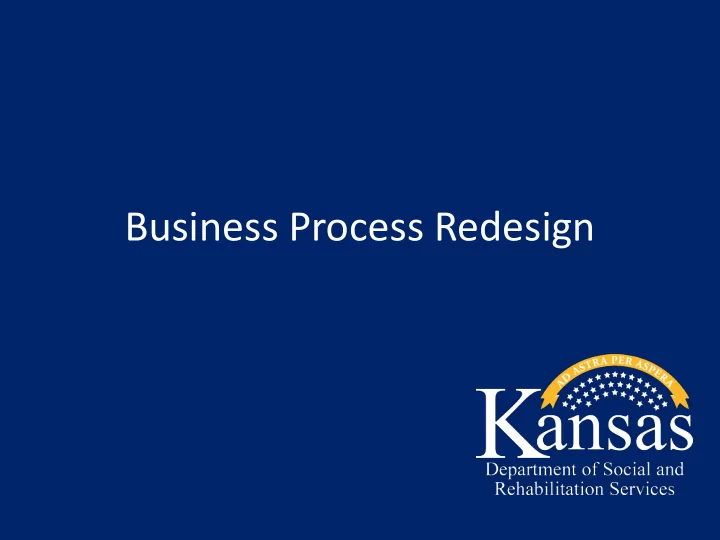

Business Process Redesign
2 EES Program Information Program Caseload Unit Cases Persons TANF Cash Assistance Average Monthly 12,547 32,622 TANF Employment Services Average Monthly 14,354 14,354 LIEAP Annual 61,985 152,563 Child Care Assistance Average Monthly 8,593 16,175 Food Assistance Average Monthly 142,124 302,669 Thursday, January 19th, House Standing Committee on Government Efficiency 2012
3 Business Process Redesign (BPR) Early Accomplishments Reduce uced d 3-4 10-60 interv rview iew wait t weeks times s minutes Increa reased d Less perce centage ntage of c cases s completed ted at t first t than 5% 70% contact act Thursday, January 19th, House Standing Committee on Government Efficiency 2012
4 Business Process Redesign (BPR) Early Accomplishments Decrease reased d 25,000+ unne nece cessar ary y client nt 10,401 transacti actions ns/c /cont ontacts acts Resul ults ts: : Redu duce ced d # o of f complaints nts Reduce uced d client nt wait t time e for r essentia ial l benefi nefits ts Thursday, January 19th, House Standing Committee on Government Efficiency 2012
5 December 2011 Data • Total Clients Served through lobby and non-lobby work: 10,401 • Total Cases completed during first contact: 7,210 • Completion: 69% • Avoided Visits (2-4 additional): 14,420 – 28,840 Thu rsday, January 19th, House Standing Committee on Government Efficiency 2012
6 Additional Projected Benefits • Less interruptions so workers can process cases • Ability to focus on the task-at-hand • Improved accuracy and timeliness • Ability to focus on potentially fraudulent cases • Increased employee morale / less stress • Better community image Thursday, January 19th, House Standing Committee on Government Efficiency 2012
7 Additional Projected Benefits • Improved client experience • Ability to monitor operations in real time • Ability to manage increased caseloads • New staff able to contribute to the process quickly Thursday, January 19th, House Standing Committee on Government Efficiency 2012
8 Why Change? Caseloa eload d increa eases ses compar mpared d to o Staffing ing Program FY 2009 FY2011 SNAP: 94,499 139,000 TANF: 12,571 14,000 Eligibility Staff: 617.9 635.8 Thu rsday, January 19th, House Standing Committee on Government Efficiency 2012
9 Why Change? • To Prepare Business Processes in EES for KEES • Don’t pave cow paths • To ensure that we don’t face federal penalties for case accuracy • To be able to focus on potentially fraudulent cases • To prepare processes for paperless caseload • To increase client satisfaction • To increase employee morale Thursday, January 19th, House Standing Committee on Government Efficiency 2012
10 Findings • Benefits processing for initial applications takes 81 minutes of work, but was taking between 21 and 34 client days • Current verification and scheduling practices were creating unnecessary client visits and phone calls (3-5 , and sometimes up to 7 client contacts) prior to determination • Inconsistent verification and documentation practices • Scheduling of interviews causing extra work for clients and staff Thursday, January 19th, House Standing Committee on Government Efficiency 2012
11 Findings • 70-80% of clients aren’t in line (or on the phone) to apply. They are there because: • We take too long (Regulation expectations Vs. Client expectations) – Where’s my stuff?? I need my stuff! • We don’t complete cases the first time (95% of interviews don’t end with a determination) – forced second interaction • We were late renewing the case (70-80% of failed renewals will reapply within 3 months) Thursday, January 19th, House Standing Committee on Government Efficiency 2012
12 Process Management Principles • Clients have different needs (Triage) • First-contact resolution • Eliminate repeat visits / phone calls • Reduce rework • Real-time data and resource management Thursday, January 19th, House Standing Committee on Government Efficiency 2012
13 Thursday, January 19th, House Standing Committee on Government Efficiency 2012
Recommend
More recommend